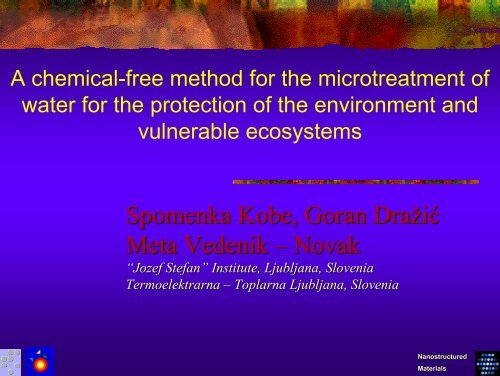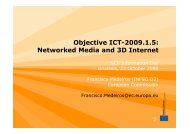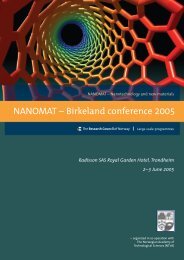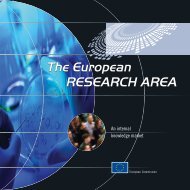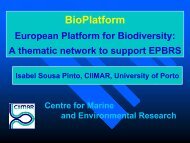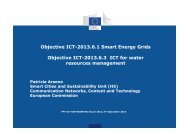Kobe TriCo - RTD
Kobe TriCo - RTD
Kobe TriCo - RTD
Create successful ePaper yourself
Turn your PDF publications into a flip-book with our unique Google optimized e-Paper software.
A chemical-free method for the microtreatment of<br />
water for the protection of the environment and<br />
vulnerable ecosystems<br />
Spomenka <strong>Kobe</strong>, , Goran Dražić<br />
Meta Vedenik – Novak<br />
“Jozef Stefan” Institute, Ljubljana, Slovenia<br />
Termoelektrarna – Toplarna Ljubljana, Slovenia<br />
Nanostructured<br />
Materials
Problem<br />
! The formation of calcium carbonate is not<br />
only a common ionic reaction that takes place<br />
in natural processes, but consequences also a<br />
problem known as scaling, which is present in<br />
our every day’s life and in various industrial<br />
processes and technologies.<br />
Nanostructured<br />
Materials
Scale formation (tap water pipes)<br />
heating of tap water calcium carbonate scale<br />
prevention: chemicals<br />
chemical pollution of the environment<br />
4 cm thick scale in the<br />
tap water tube<br />
http://www.dhvi.com/applications_fluidentry.htm
Chemical Water Treatment<br />
! Chemicals<br />
! Polyphosphates<br />
detrimental for the<br />
environment<br />
! Not easy to control<br />
the quantity due to<br />
the variations in the<br />
amount of carbonates<br />
in hard water<br />
! Harmful to the health of<br />
humans, if such water is<br />
used as drinking water.<br />
! Polyphosphates<br />
decompose at higher T<br />
than 60 o C and as such<br />
are useless anyway<br />
Nanostructured<br />
Materials
Possible solution - physical method<br />
nucleation and crystallization of calcium carbonate can be influenced by a<br />
magnetic field<br />
1945: First patent (Belgium)<br />
commercial devices are used for decades<br />
Reported effects:<br />
2002: How it works (Does it work at all)<br />
•decrease of scale formation<br />
•decrease of the nucleation rate of CaCO 3<br />
•formation of soft scale with different structure<br />
•increase ratio of aragonite / calcite<br />
•memory effect<br />
•particle size
Explanations<br />
Hypothesis:<br />
•changes in structure of (liquid) water<br />
•changes in electro-kinetic zeta potential<br />
•direct effect of the magnetic field on precipitation<br />
•heterogeneous nucleation of CaCO3 on FeOOH (goethite)<br />
•the influence of Zn 2+ and Cu 2+ (and Si 4+ ) ions<br />
•Lorentz-force induced deformation of diffuse layer<br />
Scope of our previous work:<br />
preliminary study of nucleation & crystallization using various<br />
analytical methods (FT-IR, X-ray, electron microscopy)
The inovation<br />
! It was confirmed that the density of the magnetic field<br />
has an important impact on the amounts of the different<br />
crystal forms of CaCO 3<br />
.<br />
! The soft scale of aragonite or vaterite formed with the<br />
influence of the applied magnetic field is washed away<br />
from the exposed surfaces or can be easily removed.<br />
There is no doubt that magnetic water treatment works<br />
in practice, and this is now already confirmed by<br />
applying sophisticated quantum mechanical calculations<br />
to explain the phenomenon. In addition, the<br />
experimental results can be explained by applying the<br />
magneto hydrodynamic equations of flow.<br />
Nanostructured<br />
Materials
Magnetic Water Treatment<br />
! The magnetic treatment of water is becoming an<br />
important alternative to the chemical treatment in<br />
preventing a lime scale formation in industrial and<br />
some other commercial water systems (e.g.<br />
heating boilers).<br />
! Scale deposits increase operating and<br />
maintenance costs by lowering the flow capacities<br />
and increasing the energy consumption of pumps in<br />
cool water systems and by lowering the heat<br />
transfer in hot water systems with heat exchangers<br />
and evaporators.<br />
Nanostructured<br />
Materials
Previous work - laboratory<br />
Model solution<br />
•dissolving fine CaCO 3 powder by bubbling CO 2 gas<br />
•membrane filtering<br />
•equilibrium system of CaCO 3 -Ca(HCO 3 ) 2 -H 2 O<br />
TEM sample<br />
C/Cu grid<br />
Precipitation:<br />
•heating (CO 2 is removed)<br />
•blowing air through the solution (0.05 - 0.5 l/min)
Experimental results- laboratory<br />
XRD spectra of treated samples:<br />
MWT - in magnetic field (1.4T) and<br />
NT - without the magnetic field
Experimental results- laboratory<br />
Nucleation<br />
Early stages of crystallization<br />
Phase identification<br />
Chemical composition (elemental)<br />
Estimating the fraction of various phases<br />
TEM<br />
Jeol 2000 FX,Jeol 2010 F (FEG)<br />
EDXS<br />
Link Isis
Experimental results-TEM -<br />
morphology<br />
magnetic field without the field
HRTEM and X-ray studies<br />
Quantitative X-ray analyses of crystallization products<br />
Sample<br />
Magnetic<br />
field<br />
Calcite<br />
(%)<br />
Aragon.<br />
(%)<br />
1 No 90.2 9.6 0.2<br />
2 400 mT 80.0 10.4 9.6<br />
3 1220 mT 28.9 70.6 0.5<br />
Vaterite<br />
(%)<br />
HRTEM of different crystal<br />
forms of CaCO 3<br />
Nanostructured<br />
Materials
The inovation<br />
! A pilot magnetic water treatment device was developed<br />
and constructed at “Jozef Stefan” Institute and tested in<br />
practice – pilot plant in a district heating system in<br />
Ljubljana, Bežigrad.<br />
! The strong influence of the applied magnetic field on the<br />
nucleation and further crystallization of calcium<br />
carbonate in hard water was confirmed in the laboratory<br />
work with p.a. chemicals and<br />
! in the pilot plant in a district heating system with the tap<br />
water.<br />
Nanostructured<br />
Materials
Our contribution<br />
! The focus of our proposed project is to follow<br />
systematically the influence of the magnetic field<br />
on the crystal form of precipitated calcium<br />
carbonate.<br />
! in the laboratory scale and<br />
! together with the industrial partner (Termoelektrarna-<br />
Toplarna Ljubljana on the industrial level (pilot plant)<br />
Nanostructured<br />
Materials
Our contribution<br />
! From the results of our preliminary work it is expected<br />
that by the changing the strength of the magnetic field<br />
and the flow rate of the water through the system the<br />
calcite/aragonite/vaterite ratio will be varied.<br />
! The crystal form and the particle-size distribution of<br />
the precipitated calcium carbonate will be determined by<br />
using X-ray analyses and HREM.<br />
! On the industrial level a prototype of a water treatment<br />
device will be constructed and tested through the period<br />
of the project.<br />
Nanostructured<br />
Materials
Our contribution<br />
! The theoretical part of the work will be to study the<br />
mechanism(s) of the influence of magnetic filed on the<br />
nucleation and further crystallization of calcium<br />
carbonate.<br />
! Starting from the ab initio calculations the<br />
fundamental physics knowledge will be used to propose<br />
the mechanism(s) for better understanding of the<br />
phenomena.<br />
Nanostructured<br />
Materials
Experimental results-pilot plant<br />
2,5<br />
Total weight increase<br />
2<br />
Chemical<br />
IJS<br />
Commercial<br />
Weight increase (g)<br />
1,5<br />
1<br />
0,5<br />
0<br />
jun.97 sep.97 jan.98 apr.98 jul.98 nov.98 feb.99 maj.99 avg.99 dec.99<br />
Time (months)<br />
Nanostructured<br />
Materials
Type and role/expertise of the partner we need<br />
! SME for the production of MWTD’s<br />
! Governmental/Public Administration<br />
Nanostructured<br />
Materials
Expected contribution of partners<br />
! Expected contribution of the SME is to<br />
produce the devices for water treatment.<br />
! Expected contribution of Governmental/Public<br />
Administration is to participate its part in the<br />
policy for not using environmentally detrimental<br />
chemicals in preventing scaling, but the physical<br />
method,
Contribution of partners<br />
! which will on one hand contribute to the clean<br />
environment and protect vulnerable ecosystems,<br />
and<br />
! and contribute to the energy savings in the district<br />
heating systems and in industrial application. By<br />
using the physical method we will not only<br />
contribute to the clean environment, but also save<br />
the money, which is spend on chemicals.


